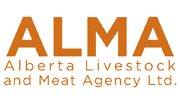NIR could make screenings more attractive for feedlots
| Project Code: | 2011C301F |
| Completed: | June 2014 |
Project Title:
Determination of energy content and utilization of feedlot ingredients using NIRS
Researchers:
Raylene Boehmer, Senior Nutritionist, Hi-Pro Feeds, Lethbridge Raylene.Boehmer@Hiprofeeds.com
Darryl Gibb PhD, Hi-Pro Feeds, Mary-Lou Swift, PhD. (Alberta Agriculture and Hi-Pro Feeds, Lethbridge and Co-operating Feedlots - TF Industries, Kolk Farms, Grandview, JF Murray Feedlots
In a study supported by ACIDF and ALMA, a feed resource that gets little respect was found to have potentially much to offer.
Weed seeds, off-types, stems, hulls, assorted bits and pieces. Considering what it can consist of, it’s no wonder cattle feeders might think twice about buying a load of grain screenings as a feed component. Then again, if you could see this imperfect feed resource as Raylene Boehmer does, you might think differently.
“It can be quite high in energy and undervalued in terms of price,” says Boehmer, Senior Nutritionist with Hi-Pro Feeds, based in Lethbridge. “The fat content has a lot to do with the energy. Some grain screenings look a lot like straw. Other times, you might have seeds in there with high oil content.”
To Boehmer, this variability is a major problem with grain screenings as livestock feed – but also the key to unlocking its value. Over the past three years, Boehmer has been lead investigator on a research project supported by the Alberta Crop Industry Development Fund (ACIDF) under the $8 million Feeding Initiative managed for the Alberta Livestock and Meat Agency (ALMA).
Objectives:Use Near InfraRed Spectroscopy (NIR) technology to determine the energy content and feed value of grain screening pellets.
${pageBreak}
What They Did:Making variability as ally
As part of the study, Boehmer worked with four Alberta feedlots to assess the energy content of the grain screening pellets that came to their facilities. She took NIR readings for 102 samples, then sent the samples out for wet chemistry analysis. Two questions mattered most. One, what’s the nutritional content of the grain screening pellets? Two, how good is NIR at predicting this, compared to the accuracy of wet chemistry?
The wet chemistry revealed, as expected, that the 102 grain screening samples were all over the map. Protein, for example, averaged 18% across the samples but ranged from 9% to 24%. Average fat content was 10%, but ranged from 4% to 23%. Neutral Detergent Fibre (or NDF, a widely used measure of fibre) was on average 33.5% but ranged from 21.6% to 52.4%. To Boehmer, this was welcome news.
“You actually need that sort of range and variation to have a more robust calibration in the NIR,” she says.
Hi-Pro Feeds then worked with AAFC to conduct a feeding trial to compare NIRS determined energy content of screenings to actual energy content determined from animal performance.
What They Learned:When comparing the NIR readings of the 102 samples to wet chemistry analysis of same, correlations were close enough to lend credibility to NIR analysis of grain screening pellets. In fact, some of the most important nutritional values were particularly close.
“The protein and fat had a very good calibration,” says Boehmer. “Overall, we were able to rework some of the NIR calibrations. We’re getting quite close on NDF as well. The ultimate goal is that you don’t have to do the wet chemistry.”
A calibration curve was also developed for fresh fecal material from 42 samples, but moisture content interfered with accuracies of starch measurements. As a result, the fecal calibration developed is for dried-ground material with correlations ranging from 0.16 (lignin) to 0.96 (nitrogen).
This work documents that NIRS can rapidly and accurately determine nutrient levels of both feed and feces. As a result of this work producers are getting value from NIRS by arranging pricing schedule of screening pellets based on analysis.
What It Means:NIR gives the buyer crucial information
Until recently, it was a leap of faith for a feedlot operator to buy a truckload of grain screening pellets. The material could be an economical addition to a ration, or could add relatively little to its feed value.
As Raylene Boehmer sees it, grain screening pellets can be a worthwhile buy, depending on the price being paid. A 30-second NIR reading can help make sure the feedlot pays what the feed is actually worth.
“Right now, feedlots have been buying pellets based on fat content,” says Boehmer. “If the feedlot wants 8% fat, for example, they can use NIR to quickly assess whether the shipment meets that level before receiving it. If the fat comes in at 6%, you can either reject the shipment or adjust the price accordingly. One feedlot owner told me that being able to accurately predict fat, by itself, would pay for his NIR.”
${pageBreak}








